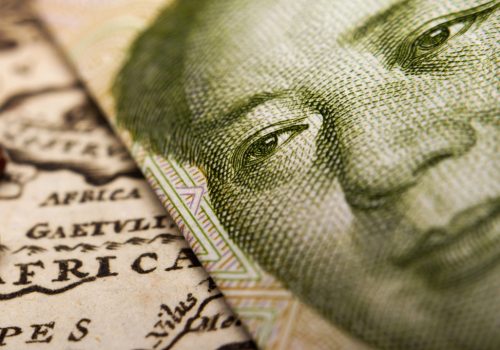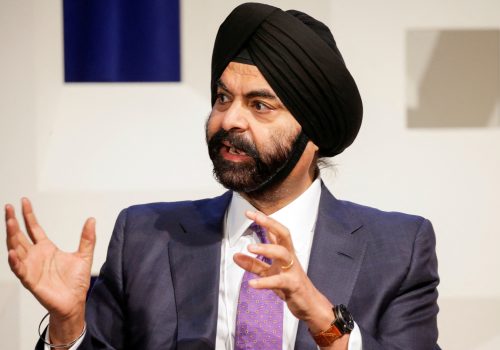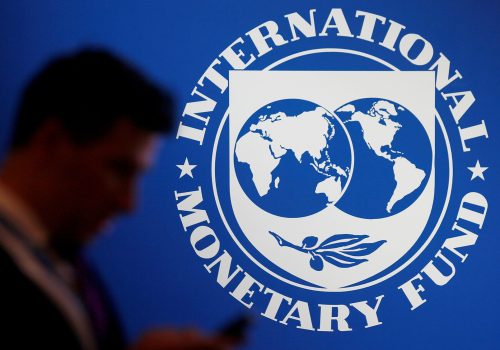Essential but unevenly distributed: IMF’s response to sovereign debt and financial crises
The global economy will face serious debt challenges in 2023 and onwards. As seen in Figure 1, public debt has risen over the past decade. The pandemic, Russia’s invasion of Ukraine, and rapid rate hikes by the Federal Reserve and other major central banks have only made matters worse—especially in low and middle-income economies. According to an International Monetary Fund (IMF) report, debt vulnerabilities are rising across many economies.
Fifty-three economies—including Argentina, Egypt, Pakistan, and Nigeria—are in an especially fragile condition because they have either defaulted on some of their debts, or have debt levels that the IMF considers unsustainable. Given their 5 percent share in the global economy, this may not sound alarming. However, considering the contagion phenomenon in financial markets—and the fact that these fifty-three economies are home to about 20 percent of the world’s population—debt distress, and its social, political, and economic ramifications could pose serious threats to the global economy. Acknowledging these dire conditions, the IMF has redoubled its efforts to help its member countries avoid the worst of debt crises.
How does IMF financial assistance work?
The IMF’s financial assistance is intended to provide financial support for countries that are experiencing or at risk of financial crises, including balance of payment (BoP) crises, banking crises, currency crises, or external/internal debt crises. The IMF’s financial assistance provides breathing space for governments to devise and gradually implement corrective policies. Hence, the IMF’s financial assistance is always associated with a set of reform policies tailored for the country in crisis. These may include monetary policy and exchange rate policy reforms, and other sets of economic-wide reforms broadly referred to as Structural Adjustments or Reforms. By implementing these reforms, the country is expected to restore long-run financial stability and growth in its economy and rebuild domestic and foreign investors’ faith in the country’s economy.
Table 1 provides a breakdown of the IMF’s financial assistance accounts and types. Broadly speaking, IMF financial assistance can take three forms. First is lending at an interest rate determined by the average of interest rates in world major currencies. Loans extended under the General Resources Account (GRA) are of this type. Second is lending at concessional terms which are extended at very low or no interest rates to low-income economies. Financial assistance through the Poverty Reduction and Growth Trust (PRGT) falls under this category. The third form of IMF financial assistance is through the Catastrophe Containment and Relief Trust (CCRT). This is a debt relief grant for heavily indebted, low-income economies facing debt distress and financial turmoil. Figure 2 shows the value of all IMF financial assistance between 2020 and 2022 for each type and recipient country. More than three-quarters of all IMF financing during the 2020-22 period was through the Flexible Credit Line (58 percent of the total) and the Extended Fund Facility (19 percent of the total).
Latin America and the Caribbean have been the IMF’s largest clients.
In fiscal year (FY) 2022, the IMF provided $113 billion of financial assistance to twenty three of its member countries, 90 percent of which is dedicated to Latin American and Caribbean economies. Two economies in Latin America accounted for $91 billion (or 80 percent of the IMF’s financial assistance in 2022): Argentina with $43 billion and Mexico with $48 billion. FY2022 was not an anomaly in the IMF’s financial assistance pattern. As seen in Figure 3, 71 percent of all IMF financial assistance between 2020-22 (including FCL) was allocated for the Latin America and Caribbean region.
However, it is important to note that the type of financial assistance IMF has provided in the form of FCL —for example to Mexico and Columbia— is drastically different in nature from the assistance provided to Argentina in the form of EFF. In particular, FCL is designed as a crisis-prevention and crisis-mitigation credit line for countries that have strong policy frameworks and solid track records in their economic performance. Hence, the country may or may not decide to use all or even a portion of this line of credit that is allocated to them. For example, Mexico has drawn nothing from the total amount of 80.214 billion SDR made available to them through FCL facility between 2020 and 2022. In contrast, Argentina has drawn 17.5 billion SDR from the 31.914 billion SDR EFF assistance provided to them. It must be noted here that IMF extends EFF to a country facing major medium-term BoP challenges because of various structural issues that will necessitate some time to address. IMF’s lending commitments site provides updated detailed information on the type and amount of assistances IMF has allocated for each member country from its first day of inception, the amount drawn from the allocated funds, and the outstanding balances.
After Latin America, the Sub-Saharan Africa region is the IMF’s main client. It is followed by a few countries in other regions such as Egypt in the Middle East and North Africa, and Pakistan in South Asia, which are highlighted in Figure 4.
The IMF should reexamine the uneven distribution of its financial resources.
The case in hand is the IMF’s uneven response to economies in Latin America versus those in Sub-Saharan Africa. While both regions suffer frequently from debt and BoP crises, Latin American economies tend to get larger IMF packages than African economies, even when their IMF quotas are considered. For example, Argentina’s most recent IMF package (arranged March 25 2022) was about $43 billion, which is about 1,000 percent of its quota and $950 million per capita. Moreover, program aimed to help Argentina repay its outstanding IMF debt from an unsuccessful 2018 $57-billion IMF program.
In contrast, Zambia’s most recent IMF package (approved August 31 2022) was about $1.3 billion, or 100 percent of its quota and about $73 million per capita. A careful look at the IMF’s financial assistance history will surface many more such examples of potentially uneven treatment. Pakistan and Egypt are two other countries that have received substantial and frequent financial assistance from the IMF over the past decades while other countries in their respective regions have had less luck in that front. While citizens and policymakers in Latin America, Pakistan, and Egypt may reject the notion that the IMF has treated them favorably over the years, a close look at other countries such Sri Lanka and Lebanon provides a glimpse of what could happen to economies in crises when IMF assistance is not immediately there to support them.
Conclusion
The global economy is facing multifaceted challenges that are increasingly interconnected and transnational in nature. Bretton Woods Institutions, such as the IMF and the World Bank, are tasked with addressing many of these challenges—including the debt distress faced by many low income and emerging economies. However, as shown above, their responses to crises have not been equitable across different regions and countries. As firefighters of the global economy, these institutions should respond to crises on equitable terms across all their members. Otherwise, they risk being viewed as politically motivated, undermining their effectiveness and relevance in the governance structure of the global economy and financial relations.
Recent debt relief grants allocated to many low-income economies in Sub-Saharan Africa through the CCRT and the last month’s visit of IMF’s managing director, Kristalina Georgieva, to Africa and engaging with African leaders are steps in the right direction. However, they must be followed by more favorable and creative financing schemes for debt-distressed low-income African economies, where debt vulnerabilities were exacerbated by the global pandemic and skyrocketing global food and energy prices.
Amin Mohseni-Cheraghlou is a macroeconomist with the GeoEconomics Center and leads the Atlantic Council’s Bretton Woods 2.0 Project. He is also an assistant professor of economics at American University in Washington DC. @AMohseniC

At the intersection of economics, finance, and foreign policy, the GeoEconomics Center is a translation hub with the goal of helping shape a better global economic future.
Further reading
Mon, Mar 6, 2023
China in Sub-Saharan Africa: Reaching far beyond natural resources
Issue Brief By
What are the implications of China's expanding involvement in Sub-Saharan Africa's investment, trade, cultural, and security landscape?
Thu, Feb 23, 2023
The big questions (and answers) about Ajay Banga’s nomination to lead the World Bank
New Atlanticist By
What to know about the former Mastercard chief executive officer's surprise nomination to lead the World Bank.
Wed, Nov 30, 2022
A badly designed Ukraine bailout could backfire on the IMF. Here’s how to get it right.
New Atlanticist By Martin Mühleisen
The IMF should stick to what it does best in aiding Ukraine: Using its macroeconomic expertise to corral broader support while sticking to its guidelines for its own loan.
Image: Washington Dc: IMF entrance with sign of International Monetary Fund and logo


